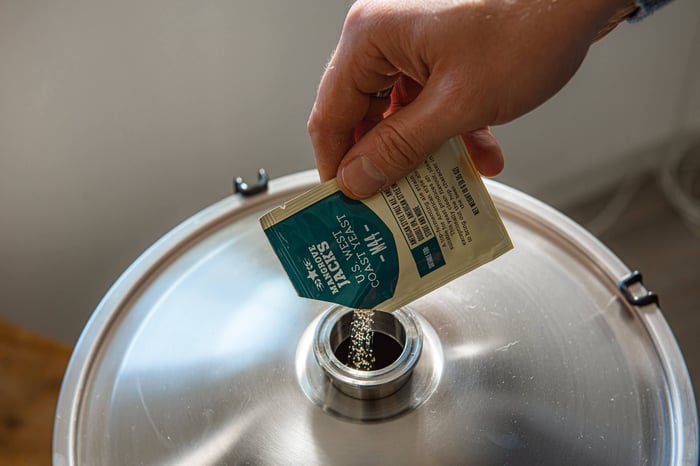Fermentation transforms simple wort into complex, flavourful beer through the remarkable work of yeast. This biological process, where Saccharomyces cerevisiae converts sugars into ethanol and carbon dioxide, forms the heart of brewing craft.
Let's explore the science behind fermentation and how understanding these processes elevates your brewing game.
The Fermentation Process Explained
The Biochemical Foundation During fermentation, yeast enzymes break down glucose and other fermentable sugars through glycolysis, producing ethanol, CO2, and various flavour compounds. This metabolic process occurs in several distinct phases, each contributing different characteristics to your final beer.
Enzymatic Activity and Flavour Development Beyond alcohol production, yeast generates esters, phenols, and other organic compounds that define your beer's character. Temperature and yeast strain selection directly influence which enzymes activate, making these choices crucial for flavour outcomes.
Scientific Approach to Fermentation Monitoring
Specific Gravity: Your Primary Tool Forget about judging fermentation progress by airlock activity – that's unreliable science. Specific gravity measurements using hydrometers or refractometers provide accurate data about remaining fermentable sugars.
The standard protocol requires consistent readings over 2-3 days to confirm fermentation completion. This methodology ensures you're measuring actual sugar depletion rather than temporary yeast dormancy.
Digital Monitoring Solutions Modern European brewers increasingly utilise digital monitoring systems that track temperature, specific gravity, and fermentation curves continuously. These tools provide valuable data for recipe refinement and quality control.
Temperature Control: The Critical Variable
Yeast Strain Optimisation Different yeast strains exhibit varying enzymatic activity at different temperatures. Understanding these relationships allows you to manipulate fermentation profiles deliberately.
European Climate Considerations
- Northern regions: Excellent for lager fermentation (8-12°C)
- Mediterranean areas: Consider temperature-tolerant strains or cooling systems
- Continental climates: Seasonal brewing adjustments necessary
Recommended Temperature Ranges (Celsius)
- Lager yeasts: 8-12°C
- Ale yeasts: 18-22°C
- Belgian strains: 20-25°C
- Kveik varieties: 25-35°C
Pro Technique: Target the lower third of your yeast's temperature range initially, then allow gradual temperature rise during active fermentation. This promotes clean fermentation whilst encouraging complete attenuation.
Fermentation Phase Analysis
Lag Phase (0-15 hours): Cellular Preparation Yeast cells adapt to their new environment, synthesising enzymes and reproductive machinery. Cell membrane permeability increases as yeasts prepare for sugar metabolism.
Exponential Growth (4 hours - 4 days): Peak Activity Rapid cell division occurs alongside vigorous sugar consumption. Krausen formation indicates protein and lipid metabolism byproducts combining with CO2 bubbles.
Stationary Phase (3-10 days): Metabolic Cleanup Cell growth plateaus whilst metabolism continues. Yeast begins processing secondary metabolites, reducing diacetyl, acetaldehyde, and higher alcohols through enzymatic conversion.
Decline Phase: Maturation Yeast autolyzes gradually whilst remaining active cells continue flavour compound processing. Beer clarity improves as proteins precipitate and cells flocculate.
Quality Control During Fermentation
Visual Assessment Techniques Clear fermentation vessels allow non-invasive monitoring. Healthy fermentation exhibits:
- Vigorous krausen formation
- Gradual colour changes (white to cream to brown)
- Steady CO2 evolution
- Clear wort beneath yeast layer
Common Issues and Solutions
- Sluggish fermentation: Check temperature, consider yeast nutrients
- Excessive esters: Reduce temperature, control yeast pitching rates
- Diacetyl presence: Extend fermentation time, maintain adequate temperatures
Post-Fermentation Conditioning
Cold Conditioning Benefits Reducing temperature post-fermentation promotes protein precipitation and flavour maturation. European brewing traditions emphasise this lagering process, even for ale styles.
Secondary Fermentation Considerations Modern understanding suggests primary fermentation suffices for most styles. Secondary transfers introduce oxidation risks that rarely justify potential benefits, except for specific applications like fruit additions or extended aging.
Regional Brewing Applications
Traditional European Styles
- German lagers: Precise temperature control essential
- Belgian ales: Complex yeast management required
- British bitters: Session-friendly fermentation profiles
- Czech pilsners: Extended conditioning periods
Understanding fermentation science empowers you to recreate these classic styles with authenticity and consistency.
Ready to apply this knowledge? Explore our detailed guides on beer bottling techniques and professional kegging methods to complete your brewing process.
For technical questions or brewing consultations, contact our team. We're here to support your brewing journey with scientific expertise.
L'équipe du Grainfather










